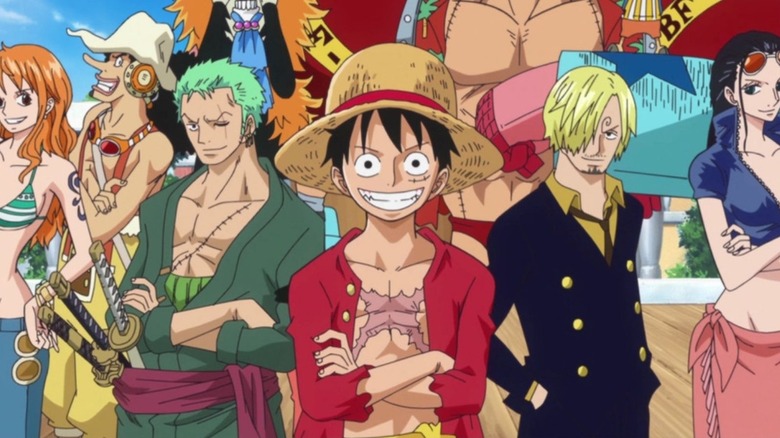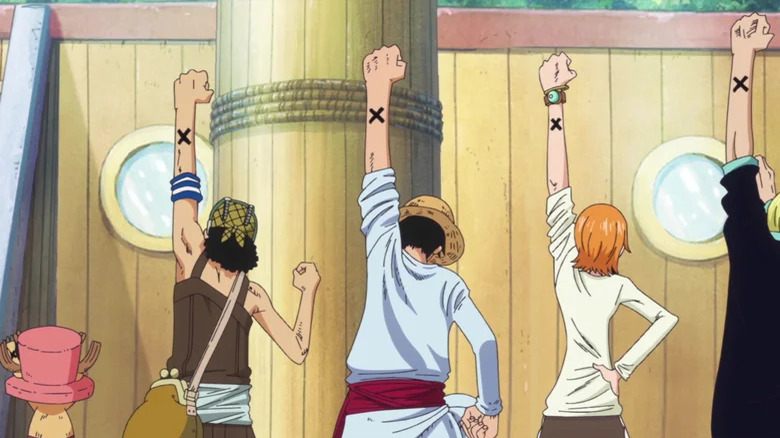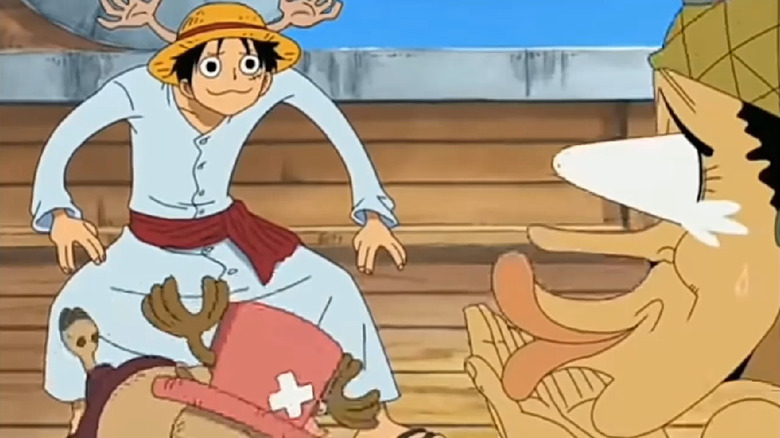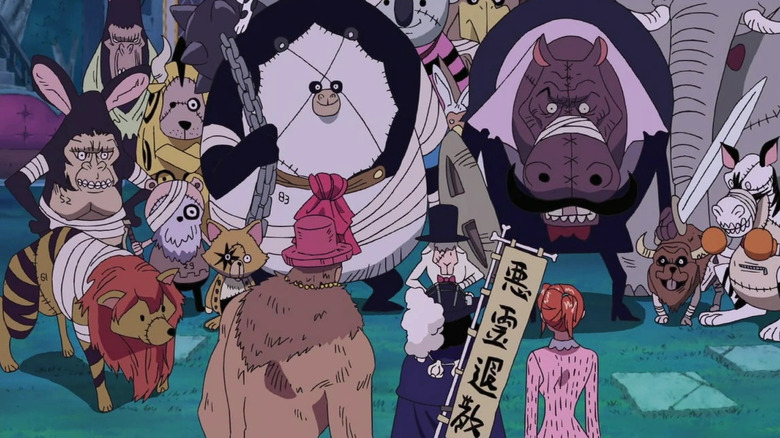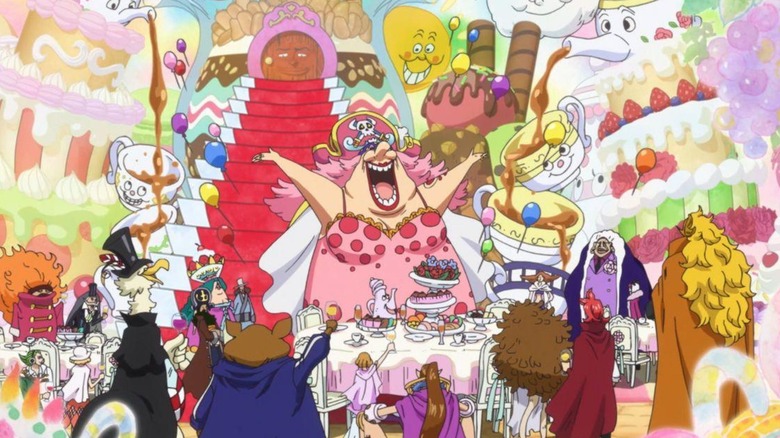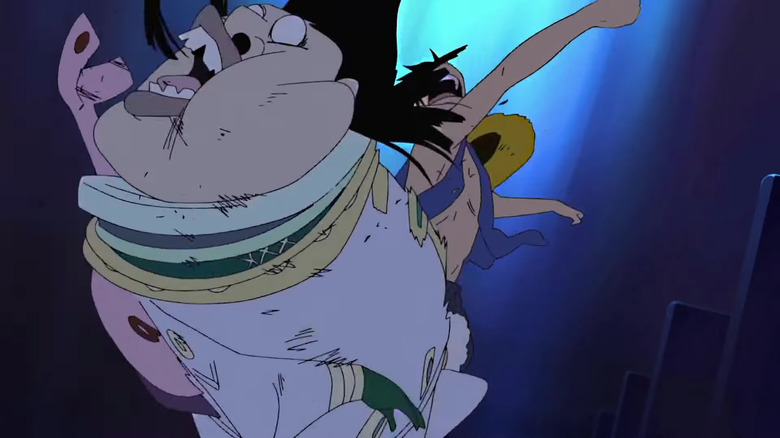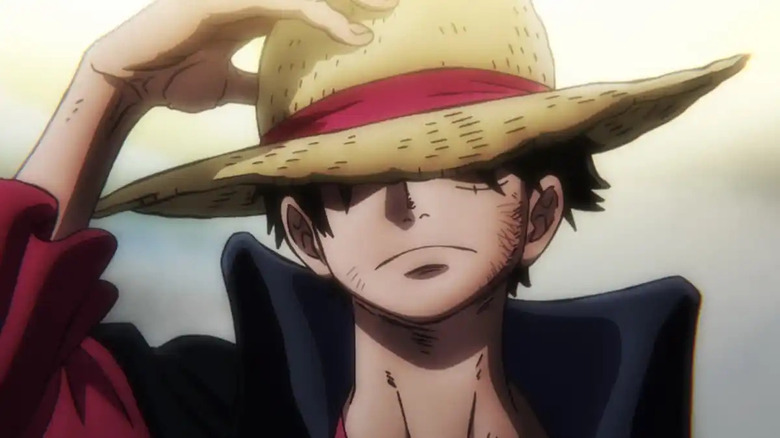One Piece Is An Epic Adventure Anime Worth Its Legendary Reputation And Long Journey
(Welcome to Ani-time Ani-where, a regular column dedicated to helping the uninitiated understand and appreciate the world of anime.)
I've been lucky enough to write this column for four years now, allowing me to explore and recommend anime both new and classic with a focus on introducing newcomers to the art form. I try to end every year by recommending a longer, beloved anime — one that represents why the medium has taken the world by storm and why it is unlike any other.
After four years, it is finally time to embark on an epic high-seas adventure, to brave the perilous grand line of 1,000 episodes (and more) in search of wealth, fame, and power, just like the pirate Gol D. Roger once did. That's right! It's time to come aboard and bring along all your hopes and dreams because together, we will find the "One Piece."
This is an anime that needs no introduction. One of the longest-running anime and manga of all time, Eiichiro Oda's magnum opus first debuted in Weekly Shonen Jump back in 1997 before getting an anime adaptation in 1999 by Toei Animation. What a first glance feels like a fun Saturday morning cartoon quickly evolved into an unparalleled leviathan of the industry, as well as one of the biggest and best works of fiction of the last century.
The story follows Monkey D. Luffy, a wide-eyed kid with big dreams and stretchy powers who sets out on a grand adventure with his crew to find the legendary One Piece and become King of the Pirates. From there, the story becomes an epic about friendship and adventure, with one of the most fleshed-out fictional worlds since Middle-earth.
Grab your pirate hat, unleash your weirdest laugh, and experience the show that inspired not one, but two remakes.
What makes it great
Let's get something out of the way. "One Piece" is quite long, yes. But while that is the biggest barrier to getting started on the anime, it's also its biggest strength. The beauty of long-running stories, particularly anime and manga, is seeing how the world changes and expands with time and how characters grow and develop. This is why the world of "One Piece" is akin to that of "Star Wars" or "Lord of the Rings"; it feels real and lived-in, and the characters change over time.
The characters also become more complex with time as their arcs progress and we come to know more about them. Every character, no matter how small, has depth, motivation, flaws, and dimensions. They even get some of the most devastating and heartbreaking backstories in all of anime. Take Usopp, the comic relief and designated liar of the Straw Hat Pirates. We watch him go from a useless coward to becoming a dependable (if still cowardly) member of the team and a god of sorts (it's a long story).
Likewise, the world of "One Piece" grows and changes even when the main characters aren't around. We constantly see background events slowly take shape even in smaller story arcs, building up to cataclysmic changes that forever alter the world and the people in it. Much like "Breaking Bad," the world of "One Piece" is one filled with callbacks. Oda is a master at connecting the dots and making each aspect of the story feel important, paying off even the smallest of set-ups years and events decades later. This makes the 1,000+ episode count not just a necessity but a feature, as the long wait to get a resolution makes it immensely more satisfying.
Variation is key
At its core, "One Piece" is just a jolly great pirate show. It has everything — sword fights aplenty, exquisite Jolly Rogers and ship designs, catchy and cool songs, and of course, lots of treasure and camaraderie. Author Eiichiro Oda did his homework and filled the world of "One Piece" with nods to real-life pirate history, which he then made cartoonishly better. "Treasure Island" may be about an island filled with treasure, but "One Piece" offers a floating island in the sky made of gold.
Indeed, the key to "One Piece" is variation. There may be over 1,000 episodes of the anime (and dozens of islands that the Straw Hats visit), but no two of them are the same. Sure, there is a formula, wherein the Straw Hats visit a new island, cause trouble, maybe start a revolution or two, get in a fight, and finally have a big feast at the end. Oda and "One Piece" sustain this formula by adding progressively new creative stories and locations that feel unique and never repetitive.
Only in "One Piece" can you go from a poignant fight against a dictatorial regime in one arc to a zany race side quest and a "Scooby Doo" horror slapstick comedy on an island of monsters and zombies, only to be followed by a prison break (a la "The Great Escape"). There are also gladiatorial tournament arcs and even a 1930s Betty Boop-like island made of singing candy!
More than anything, "One Piece" is unabashedly, unequivocally, a cartoon. And I mean this as a huge compliment. This is an anime that fully embraces the magic of animation and cartoon logic.
Long live cartoons
"One Piece" has countless silly, irreverent visual gags that make the sudden turn to hard-hitting action and heartbreaking drama all the more effective — because it is both unexpected and fitting. Few shows thrive on the absolutely outlandish world of wild animation quite like "One Piece," in terms of ridiculous character designs, but also over-the-top expressions. Characters have cartoonish body proportions and expressions, like how their eyes are constantly popping out of their eye sockets like "Looney Tunes" characters (including the ship!).
Just like there are countless fantastical islands, there are countless fantastical creatures and critters inhabiting said islands. "One Piece" has more weird creatures than "Star Wars," Ghibli films, and "Avatar: The Last Airbender" combined, ranging from cute to adorable to scary to weird to kung-fu fighting. What's more, every minuscule detail, from the flora to the fauna, is there for a reason, and it impacts the larger world of the anime — like how each island's mode of transportation is informed by the unique weather and conditions of that island.
Then there are the laughs. This is where Oda's distinct character designs shine brightest. It's not just that every single character has a unique look and quirks, but also each of them has a specific laugh (enough to fill the entire alphabet). This shows how much "One Piece" prizes cartoonish fun while at the same time aiding its world-building.
What it adds to the conversation
Like the best fictional worlds, the setting of "One Piece" feels like a living, breathing place with many moving parts and countless other stories happening simultaneously just off-screen. Indeed, for the first half of the story (which is mostly a hangout show focusing on fun little adventures), we don't really see or hear about pirates other than the ones that Luffy and his crew fight directly. And yet, we slowly but surely get word of things happening in the larger world, including conflicts starting and escalating until they blow up on screen (forever changing the world of "One Piece" and directly impacting the Straw Hats).
Everything has a consequence, whether because of the main characters or not. A side character Luffy was kind towards early in the story rises to prominence and comes to Luffy's rescue years later when they are the leader of a major organization. Everything has a point, and everything may eventually come into play. But what makes "One Piece" special is that it manages to do all this while always remaining an entertainingly oddball adventure. See also: The vastly underrated Skypiea arc, one of the best in the story.
What starts as an enjoyable and ludicrous quest to find an island in the sky ends up involving a unique and fleshed-out world of its own (a fricking island in the sky!), complete with its own culture and technology. But it also provides poignant real-world commentary about colonialism and the displacement of indigenous populations with the aid of real-world imagery like Mesoamerican-inspired designs and some incredibly exciting fights (such as the one where Luffy very literally punches a god before he escapes to the moon). This all ends up having huge implications for the lore of the anime and even bigger repercussions for storylines to come.
The politics of One Piece
An underrated yet still vital aspect of "One Piece" is Eiichiro Oda's mastery of blending real-world issues and commentary with his narrative. As mentioned, each story arc mixes comedy with lore with action with character development, but they also add politics and social commentary. Take Skypiea again. What starts as a pleasant adventure on a floating island in the sky quickly becomes a poignant story of displacement and colonialism. We learn that the original inhabitants of the island were driven out of their homes and victims of violence by the wealthier, better-armed invaders, and both tones mix seamlessly.
Indeed, every arc of the show touches on a specific social issue. Luffy and his crew may not be heroes (Luffy hates the word hero since they share their spoils, and he is a pirate), but they're definitely freedom fighters. It's become a meme that, while most anime does feature some sort of lesson about never giving up or relying on friendship, the biggest lesson in "One Piece" is that governments are not to be trusted and the military serves to maintain propaganda and the wealthy (which is true).
Throughout the show, we see that as bad as some pirates can be, the real villains are the world leaders who dehumanize people, support slavery and human trafficking, and manipulate the media and the masses. From racism to the military-industrial complex to feeding drugs to impoverished communities and much more," One Piece" is without a doubt the biggest piece of popular culture that also aspires to radicalize young people outside of "The Hunger Games," and it rules. Remember kids, pirates hunting for treasure are fun, but the real good guys are those who rebel against corrupt governments.
Why non-anime fans should check it out
Do you like pirates? Do you like tales of friendship? Do you like very cool character designs and all sorts of imaginative worlds? Do you like tales of toppling corrupt governments? Then "One Piece" is the show for you.
Yes, the episode count can be daunting at first, but the further along you go, the sadder you will become upon realizing you only have so many episodes left. "One Piece" has some of the most well-defined and developed characters in all of anime, a mismatched group of dreamers bound together by found family. It also has one of the most fleshed-out worlds in fiction, as well as one of the most surprisingly inclusive worlds in anime (including multiple nuanced gender-fluid and queer characters with agency and depth). There's a reason why these characters are so well-defined that they work perfectly even in live-action.
The episodic nature of the story arcs (going from one island to the next) also makes "One Piece" quite easy to watch or read, as you can always just pause in between islands. The result is an extremely binge-watchable anime that lives up to every part of its legendary reputation. This is a massive show; it balances so many different tones and genres that there is something here for every type of fan (and no two fans will come away with the same experience). Whether you're in for the weird cartoon elements, for the camaraderie, for the freedom fighting, or for the fun hero's journey, "One Piece" is for everyone.
There will never be another "One Piece," so why not come aboard now?
Watch This If You Like: "Our Flag Means Death," "Treasure Planet," "A Series of Unfortunate Events"
"One Piece" is streaming on Crunchyroll.
